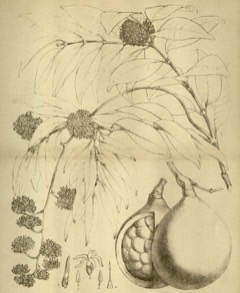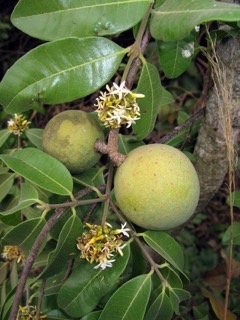 |
|
edibleplants.org |
 |
| © Robert v. Blittersdorff; African plants - A Photo Guide |
Translate this page:
Summary
Physical Characteristics

 Landolphia kirkii is an evergreen Climber growing to 15 m (49ft) by 0.3 m (1ft in) at a fast rate.
Landolphia kirkii is an evergreen Climber growing to 15 m (49ft) by 0.3 m (1ft in) at a fast rate.
See above for USDA hardiness. It is hardy to UK zone 10.
Suitable for: light (sandy), medium (loamy) and heavy (clay) soils and prefers well-drained soil. Suitable pH: mildly acid, neutral and basic (mildly alkaline) soils. It can grow in semi-shade (light woodland) or no shade. It prefers moist soil.
UK Hardiness Map
US Hardiness Map
Synonyms
Landolphia delagoensis (Dewèvre) Pierre Landolphia dondeensis Busse Landolphia polyantha K.Schum. Vahea kirkii (Dyer ex Hook.f.) Sadeb.
Plant Habitats
Edible Uses
Edible Parts: Fruit
Edible Uses:
Fruit - raw[323 ]. A juicy pulp, it is sweet with a slightly acid flavour[398 ]. They are popular with those in the know, but their tartness can put off the uninitiated[323 ]. The rounded to oval, dull green but spotted, fruit is a many-seeded berry with a hard skin up to 15cm in diameter[398 ].
References More on Edible Uses
Medicinal Uses
Plants For A Future can not take any responsibility for any adverse effects from the use of plants. Always seek advice from a professional before using a plant medicinally.
None known
References More on Medicinal Uses
The Bookshop: Edible Plant Books
Our Latest books on Perennial Plants For Food Forests and Permaculture Gardens in paperback or digital formats.

Edible Tropical Plants
Food Forest Plants for Hotter Conditions: 250+ Plants For Tropical Food Forests & Permaculture Gardens.
More

Edible Temperate Plants
Plants for Your Food Forest: 500 Plants for Temperate Food Forests & Permaculture Gardens.
More

More Books
PFAF have eight books available in paperback and digital formats. Browse the shop for more information.
Shop Now
Other Uses
A good quality latex, suitable for making into rubber, is obtained from the stems[323 ]. It is only used locally[323 ]. The latex can be coagulated with sea water or with lime juice[46 ]. The flexible stems can be used as rope[398 ].
Special Uses
Carbon Farming
References More on Other Uses
Cultivation details
Industrial Crop: Hydrocarbon Management: Coppice Regional Crop
A plant of subtropical to tropical areas, where it is usually found growing in moister areas[323 ].
Carbon Farming
-
Industrial Crop: Hydrocarbon
Materials, chemicals and energy include bioplastics, rubber, biomass products gasoline, jet fuel, diesel, butane, propane, biogas. Plants are usually resprouting plants and saps.
-
Management: Coppice
Cut to the ground repeatedly - resprouting vigorously. Non-destructive management systems maintaining the soil organic carbon.
-
Regional Crop
These crops have been domesticated and cultivated regionally but have not been adopted elsewhere and are typically not traded globally, Examples in this broad category include perennial cottons and many nuts and staple fruits.
References Carbon Farming Information and Carbon Sequestration Information
Temperature Converter
Type a value in the Celsius field to convert the value to Fahrenheit:
Fahrenheit:
The PFAF Bookshop
Plants For A Future have a number of books available in paperback and digital form. Book titles include Edible Plants, Edible Perennials, Edible Trees,Edible Shrubs, Woodland Gardening, and Temperate Food Forest Plants. Our new book is Food Forest Plants For Hotter Conditions (Tropical and Sub-Tropical).
Shop Now
Plant Propagation
Seed
Other Names
If available other names are mentioned here
Anggur karet, Ibungu, Kirk's landolphia, Mabungo, Matwatwa, Maungo, Melktog, Mlimbo, Mpila, Mpira, Mubungu, Muhonga-ulume, Mukanga, Muungu, Muvhungo, Muwungu,Runyangarwapene, Sand apricot, Ugooto, Umkuzi, Zanzibar rubber
Native Range
AFRICA: Somalia, Kenya, Tanzania, Uganda, Central African Republic, Democratic Republic of the Congo, Mozambique, Malawi, Zambia, Zimbabwe, South Africa (KwaZulu-Natal, Limpopo)
Weed Potential
Right plant wrong place. We are currently updating this section.
Please note that a plant may be invasive in one area but may not in your area so it's worth checking.
None Known
Conservation Status
IUCN Red List of Threatened Plants Status : This taxon has not yet been assessed

Growth: S = slow M = medium F = fast. Soil: L = light (sandy) M = medium H = heavy (clay). pH: A = acid N = neutral B = basic (alkaline). Shade: F = full shade S = semi-shade N = no shade. Moisture: D = dry M = Moist We = wet Wa = water.
Now available:
Food Forest Plants for Mediterranean Conditions
350+ Perennial Plants For Mediterranean and Drier Food Forests and Permaculture Gardens.
[Paperback and eBook]
This is the third in Plants For A Future's series of plant guides for food forests tailored to
specific climate zones. Following volumes on temperate and tropical ecosystems, this book focuses
on species suited to Mediterranean conditions—regions with hot, dry summers and cool, wet winters,
often facing the added challenge of climate change.
Read More
Expert comment
Author
Dyer ex Hook.f.
Botanical References
Links / References
For a list of references used on this page please go here
A special thanks to Ken Fern for some of the information used on this page.
Readers comment
| Add a comment |
|
If you have important information about this plant that may help other users please add a comment or link below. Only comments or links that are felt to be directly relevant to a plant will be included. If you think a comment/link or information contained on this page is inaccurate or misleading we would welcome your feedback at [email protected]. If you have questions about a plant please use the Forum on this website as we do not have the resources to answer questions ourselves.
* Please note: the comments by website users are not necessarily those held by PFAF and may give misleading or inaccurate information.
To leave a comment please Register or login here All comments need to be approved so will not appear immediately.
|
Subject : Landolphia kirkii
|
|
|
|